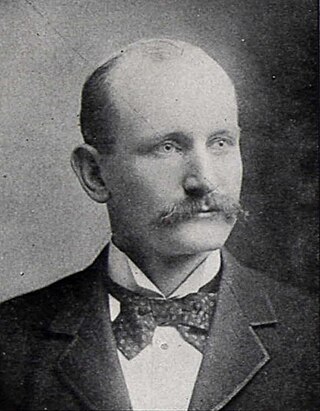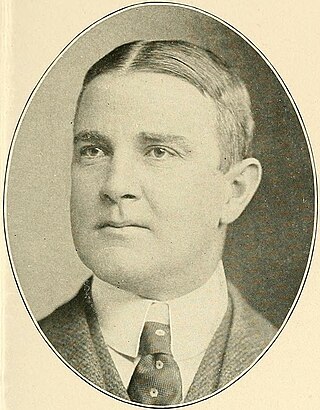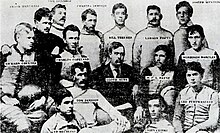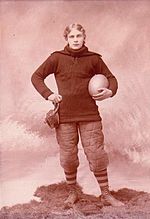The Allegheny Athletic Association was an athletic club that fielded the first ever professional American football player and later the first fully professional football team. The organization was founded in 1890 as a regional athletic club in Allegheny, Pennsylvania, which is today the North Side of Pittsburgh.
The Latrobe Athletic Association was a professional football team located in Latrobe, Pennsylvania, from 1895 until 1909. A member of the unofficial Western Pennsylvania Professional Football Circuit, the team is best known for being the first football club to play a full season while composed entirely of professional players. In 1895, team's quarterback, John Brallier, also became the first football player to openly turn professional, by accepting $10 and expenses to play for Latrobe against the Jeannette Athletic Club.

John Kinport "Sal" Brallier was one of the first professional American football players. He was nationally acknowledged as the first openly paid professional football player when he was given $10 to play for the Latrobe Athletic Association for a game against the Jeanette Athletic Association in 1895.
The Greensburg Athletic Association was an early organized football team, based in Greensburg, Pennsylvania, that played in the unofficial Western Pennsylvania Professional Football Circuit from 1890 until 1900. At times referred to as the Greensburg Athletic Club, the team began as an amateur football club in 1890 and was composed primarily of locals before several professional players were added for the 1895 season. In 1894 it was discovered that the team had secretly paid formerly Indiana Normal player, Lawson Fiscus, to play football and retained his services on salary. The team was the chief rival of another early professional football team, the Latrobe Athletic Association.
The Pittsburgh Athletic Club football team, established in 1890, was based in Pittsburgh, Pennsylvania. In 1892 the intense competition between two Pittsburgh-area clubs, the Allegheny Athletic Association and the Pittsburgh Athletic Club, led to William (Pudge) Heffelfinger becoming the first known professional football player. Heffelfinger was paid $500 by Allegheny to play in a game against Pittsburgh on November 12, 1892. As a result, Heffelfinger became the first person to be paid to play football. Allegheny would go on to win the game, 4–0, when Heffelfinger picked up a Pittsburgh fumble and ran it 35 yards for a touchdown. In 1893, Pittsburgh again made history when it signed one of its players, probably halfback Grant Dibert, to the first known pro football contract, which covered all of the team's games for the year.
The Duquesne Country and Athletic Club was a professional football team based in Pittsburgh, Pennsylvania from 1895 until 1900. The team was considered one of the best, if not the best, professional football teams in the country from 1898 until 1900. However, the team is most famous for being the first football franchise to be owned by an individual, William Chase Temple.

David J. Berry was an American football manager during the late 19th and early 20th centuries. He was the top promoter for the sport during that time period. He is credited with inventing the "all-star game concept" in 1898, and also helped to form one of the first organized football leagues in 1902.
Charles Lloyd Barney (1874-1913) was an early professional football player and strongman. In 1897 he played college football at Ohio Wesleyan University. There he was a classmate, teammate and roommate of Fielding Yost. He appeared at expositions and shows lifting horses, breaking chains, and performing other feats of strength. From 1898 through 1900, Barney played professional football for the Latrobe Athletic Association. He was best remembered, by his teammates, for lifting a piano and holding it while a man played it. In 1902, he played in the first National Football League for the Pittsburgh Stars.
Harry Wilson "Cap" Ryan was an early professional football player for the Latrobe Athletic Association from 1895 until 1906. He was also selected to be the first captain in that team's history. He played alongside John Brallier who is considered the first openly professional football player. In 1897 he was named to the "All Western Pennsylvania Team" by The Pittsburg Times.
Albert Russell Aukerman was an early professional football player-coach for the Latrobe Athletic Association. Prior to that, he was a halfback at Gettysburg College.
The Jeannette Athletic Club, also referred to as the Jeannette Indians, was an early football team, based in Jeannette, Pennsylvania from 1894 until around 1906. The team is best known for its role in the Latrobe Athletic Association's hiring of John Brallier, who became the first player to openly turn professional. This event occurred in 1895, a few days before Latrobe's game against Jeannette. Latrobe starting quarterback, Eddie Blair, due to a scheduling conflict could not play in the game. This led Latrobe manager, Dave Berry to hire Brallier to play against Jeannette for $10, plus expenses. Latrobe would go on to win that game 12-0.

Professor Louis Frederick Kirchner, misnamed in some posthumous sources as William Kirschner, was an early football player and physical instructor for the Pittsburgh Athletic Club. He may, or may not, have been one of the earliest professional football players. Even though he had never played football before 1890, he had the ability to learn and adapt to the game quickly. During the 1890s he was viewed as one of the best offensive linemen in Pennsylvania.
Pro Football: Its Ups and Downs, published in 1934, is a book by Dr. Harry March that was the first ever attempt to write a history of professional American football. March had served in several executive offices with the New York Giants of the National Football League in the late 1920s and was a founder of the second American Football League. The book, while popular and entertaining with some important information and interesting anecdotes, is often viewed as inaccurate by modern sports historians. Jack Cusack, manager of the Canton Bulldogs from 1912 to 1917, summed up the book's flaws by stating; "In my library is a book... entitled Pro Football: Its "Ups and Downs" and in my opinion it is something of a historical novel."
The 1898 Western Pennsylvania All-Star football team was a collection of early football players, from several teams in the area, to form an all-star team. The team was formed by Dave Berry, the manager of the Latrobe Athletic Association, for the purpose of playing the Duquesne Country and Athletic Club, which fielded a team composed of many of the game's stars from the era. The game between the two clubs ended in a 16-0 Duquesne victory and is considered to be the first all-star game for professional football. Contrary to popular belief, while the game was held at Exposition Park, which would be currently located inside of the city limits of Pittsburgh, Pennsylvania, the 1898 location of the game was Allegheny, Pennsylvania which was not incorporated into the city of Pittsburgh until 1907.

Stuart John "Jack" Gass was an early professional football player. He played mostly with the Latrobe Athletic Association from 1895 until 1899. In 1898, he was a member of the Western Pennsylvania All-Stars, which was a team put together by Latrobe manager Dave Berry for the purpose of challenging the star-filled Duquesne Country and Athletic Club to the first pro football all-star game held at Exposition Park in Pittsburgh. The All-Stars lost to Duquesne, 16–0. In 1897, Gass was a member of the very first all-professional football team, in Latrobe, to play a complete season together. In 1900, he played for Latrobe's rival, the Greensburg Athletic Association.

Augustus Clement Read was a college football player and the captain of the Penn State Nittany Lions football team, and a college shot putter. He was from Delano, Pennsylvania.
Oliver William Rafferty was an American football player in the early years of the sport. In 1893, he was under contract by the Allegheny Athletic Association to be paid $50 per game for the entire season. He served as team captain during that season. He returned to Allegheny in 1894 to help the club win the Western Pennsylvania Championship. In 1895 Rafferty was poised to return to play for Allegheny, however the club cancelled their season after learning of an investigation, by Amateur Athletic Union, into reports that the team had secretly paid its players.

John Moorhead Jr. was an American football player for Yale. He played alongside Walter Camp, the inventor of the modern game, during the late 1870s. He was also a member, and club president, of the Allegheny Athletic Association, an amateur football club which fielded the first recognized professional player Pudge Heffelfinger. When Allegheny formed a football team in 1890, he took over the position of center. Meanwhile a fellow former Yale player, O. D. Thompson, took over as the club's manager and played tackle.
Arthur Lamont "Tiger" McFarland was an early professional American football player who played with the Greensburg Athletic Association as well as the Latrobe Athletic Association. He later played for the Philadelphia Athletics in the 1902 version of the National Football League and for the 1903 US Football Champions, the Franklin Athletic Club. Sweet also won, with Franklin, the 1903 World Series of Football, held that December at Madison Square Garden.
American football in Western Pennsylvania, featuring the city of Pittsburgh and surrounding areas, has had a long and storied history, dating back to the early days of the sport. All levels of football, including high school football and college football, are followed passionately, and the area's National Football League (NFL) team, the Pittsburgh Steelers, is consistently one of the sport's most popular teams. Many of the NFL's top stars have come from the region as well, especially those that play quarterback, earning Western Pennsylvania the nickname "Cradle of Quarterbacks".











